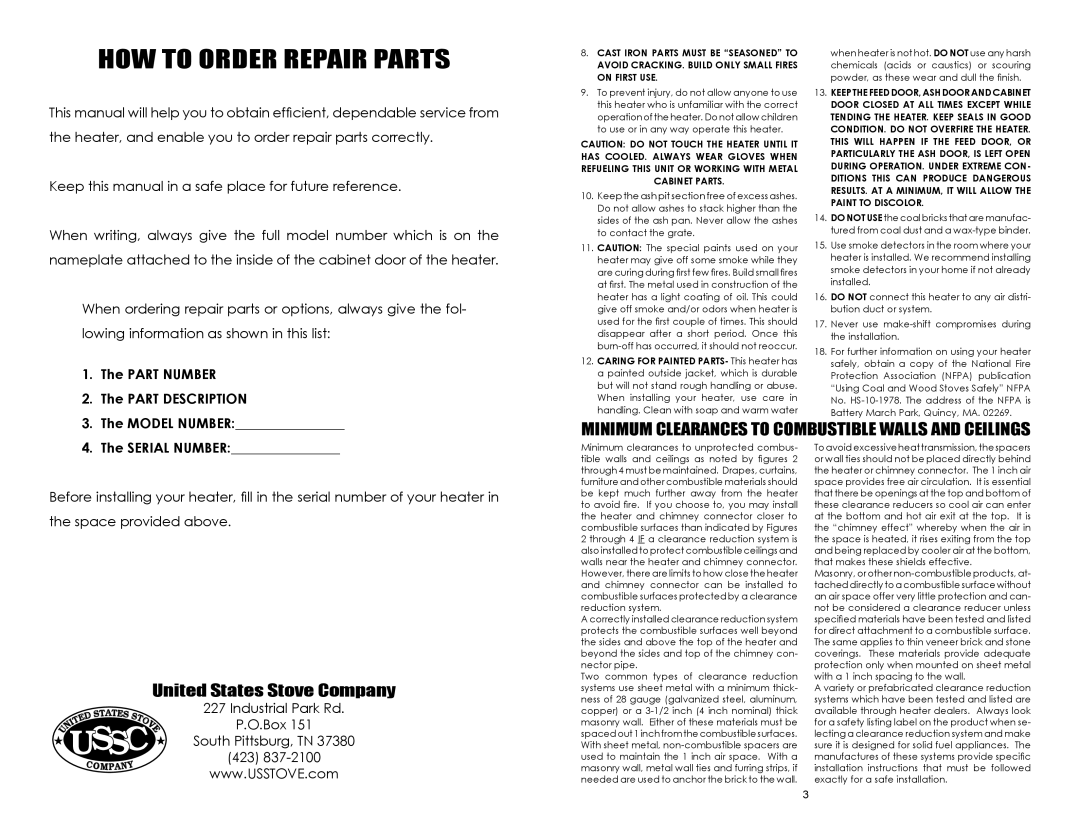HOW TO ORDER REPAIR PARTS
This manual will help you to obtain efficient, dependable service from the heater, and enable you to order repair parts correctly.
Keep this manual in a safe place for future reference.
When writing, always give the full model number which is on the nameplate attached to the inside of the cabinet door of the heater.
When ordering repair parts or options, always give the fol- lowing information as shown in this list:
1. | The PART NUMBER |
2. | The PART DESCRIPTION |
8.CAST IRON PARTS MUST BE “SEASONED” TO AVOID CRACKING. BUILD ONLY SMALL FIRES ON FIRST USE.
9.To prevent injury, do not allow anyone to use this heater who is unfamiliar with the correct operation of the heater. Do not allow children to use or in any way operate this heater.
Caution: do not touch the heater until it has cooled. Always wear gloves when refueling this unit or working with metal cabinet parts.
10.Keep the ash pit section free of excess ashes. Do not allow ashes to stack higher than the sides of the ash pan. Never allow the ashes to contact the grate.
11.CAUTION: The special paints used on your heater may give off some smoke while they are curing during first few fires. Build small fires at first. The metal used in construction of the heater has a light coating of oil. This could give off smoke and/or odors when heater is used for the first couple of times. This should disappear after a short period. Once this
12.CARING FOR PAINTED PARTS- This heater has a painted outside jacket, which is durable but will not stand rough handling or abuse. When installing your heater, use care in handling. Clean with soap and warm water
when heater is not hot. DO NOT use any harsh chemicals (acids or caustics) or scouring powder, as these wear and dull the finish.
13.KEEP THE FEED DOOR, ASH DOOR AND CABINET DOOR CLOSED AT ALL TIMES EXCEPT WHILE TENDING THE HEATER. KEEP SEALS IN GOOD CONDITION. DO NOT OVERFIRE THE HEATER. THIS WILL HAPPEN IF THE FEED DOOR, OR PARTICULARLY THE ASH DOOR, IS LEFT OPEN DURING OPERATION. UNDER EXTREME CON- DITIONS THIS CAN PRODUCE DANGEROUS RESULTS. AT A MINIMUM, IT WILL ALLOW THE PAINT TO DISCOLOR.
14.DO NOT USE the coal bricks that are manufac- tured from coal dust and a
15.Use smoke detectors in the room where your heater is installed. We recommend installing smoke detectors in your home if not already installed.
16.DO NOT connect this heater to any air distri- bution duct or system.
17.Never use
18.For further information on using your heater safely, obtain a copy of the National Fire Protection Association (NFPA) publication “Using Coal and Wood Stoves Safely” NFPA No.
3. The MODEL NUMBER:________________ |
minimum clearances to combustible walls and ceilings
4. The SERIAL NUMBER:________________ |
Before installing your heater, fill in the serial number of your heater in the space provided above.
United States Stove Company
Minimum clearances to unprotected combus- tible walls and ceilings as noted by figures 2 through 4 must be maintained. Drapes, curtains, furniture and other combustible materials should be kept much further away from the heater to avoid fire. If you choose to, you may install the heater and chimney connector closer to combustible surfaces than indicated by Figures 2 through 4 IF a clearance reduction system is also installed to protect combustible ceilings and walls near the heater and chimney connector. However, there are limits to how close the heater and chimney connector can be installed to combustible surfaces protected by a clearance reduction system.
A correctly installed clearance reduction system protects the combustible surfaces well beyond the sides and above the top of the heater and beyond the sides and top of the chimney con- nector pipe.
Two common types of clearance reduction systems use sheet metal with a minimum thick- ness of 28 gauge (galvanized steel, aluminum,
To avoid excessive heat transmission, the spacers or wall ties should not be placed directly behind the heater or chimney connector. The 1 inch air space provides free air circulation. It is essential that there be openings at the top and bottom of these clearance reducers so cool air can enter at the bottom and hot air exit at the top. It is the “chimney effect” whereby when the air in the space is heated, it rises exiting from the top and being replaced by cooler air at the bottom, that makes these shields effective.
Masonry, or other
A variety or prefabricated clearance reduction systems which have been tested and listed are
|
|
| D STATES S | T |
| |
| I | E |
| O | ||
| T |
|
|
|
| |
| USSC | |||||
N |
|
|
|
| V | |
|
|
|
| E | ||
U |
|
|
|
|
|
|
|
|
| C | Y |
|
|
|
|
|
| OMPAN |
|
|
227 Industrial Park Rd.
P.O.Box 151
South Pittsburg, TN 37380
(423)
www.USSTOVE.com
copper) or a
available through heater dealers. Always look for a safety listing label on the product when se- lecting a clearance reduction system and make sure it is designed for solid fuel appliances. The manufactures of these systems provide specific installation instructions that must be followed exactly for a safe installation.
3
